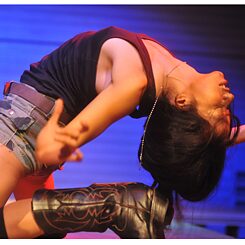Soft Skills For Sale: Eisa Jocson’s Body of Work
"This video makes me question my sexuality."
This comment by YouTube user @kittykatBflat speaks for us all upon viewing Eisa Jocson’s Macho Dancer (2013), which gained a measure of notoriety as the video of the 2016 single "How You Like My Cut" by electro-pop artist Peaches.
What else could provoke such a double-take but the incongruity of a man’s bold moves translated through a woman’s bare body? Onan empty, harshly lit stage, we witness Jocson’s metamorphosis through the slow gyration of slick hip, bicep, torso; the laconic gum-chewing and unseeing stare; sheer maleness oozing out of the female form.
This sleight-of-hand is par for the course as far as Jocson is concerned. Her practice is meant to make the audience "question fixed notions that they have in relation to what they experience."[1] The fixed notions she means to trouble involve race, gender, and class, that basic triumvirate of difference, albeit configured in the Philippine performing body. The soft skills of that body—whether used for seduction, entertainment, or caregiving in precarious migrant jobs—are always up for sale, and thus always up for questioning.
Her method in Macho Dancer is pedagogical in its directness, a precise demonstration of the postural, affective, and rhythmic vocabularies distinct to macho dancing. Although Jocson’s gender-bending garners the most attention, another reading of her performance Macho Dancer postulates a different transgression. The macho dancer is a paradoxical figure in mainstream Philippine popular culture: as the nightclub plaything of gay men and women with money, his wanton virility is also read as economic subservience to transactional feminine and queer desire. Responding directly to this climate of class shame and homophobic ridicule, Jocson becomes a macho dancer to foreground the constructive, creative processes of technique and skill formation unique to the genre. Macho Dancer was bornof months of ethnographic research by Jocson, who studied with macho dancers in Manila; her mentors instructed her to develop her own choreographic innovations. Her continued iterations of this dance form in different spaces of contemporary art call critical attention to the normalcy of economic exploitation in the Philippines, which relies on the state-sponsored export of intimate and emotional labor, from domestic work to live entertainment. At the same time, as Jocson translates the subordination of macho dancing from an atypical and privileged subject position—that of the transnational and formally educated Filipina artist—we are left to ponder the ambivalent limits of gender as "a tool for social mobility."[2]
These turns of self-reflexive critique are given space in Corponomy (2017), a performance-lecture that serves as an archive of Jocson’s works from 2009-2017. Each of these works focuses on a specific phenomenon of dance labor mapped onto the racialized andgendered Philippine body: ballet, pole dancing, and macho dancing; the hostessing work of Filipina migrant entertainers in Japanese nightclubs; and the theatrical labor of friendly creatures and Snow White character roles in Hong Kong Disneyland, that selectively hires (in the case of the creatures) and excludes (in the case of Snow White) migrant Filipino performers. Jocson dances alongside her lecture slides with the solemnity of delivering a conference exegesis, sometimes to humorous effect. There’s a moment when she duct-tapes a pair of stacked stilettos to her feet and executes pelvic rotations and wall gyrations with stony-faced exaggeration, keeping in time with projected videos of ballet warmups and competitive pole dance routines as the Dusty Springfield ballad "I Just Don’t Know What to Do with Myself" plays mournfully over the speakers.
In opening the artist’s research archive of training videos, performances, and visual references over the last decade, Corponomy reveals "different layers involved in each role transformation."[3] Common to these layers is the relational bond of learning evident in the generous footage of rehearsal videos withJocson’steachers and collaborators, and the scholarly care with which she names conceptual definitions and sources. This reckoning with the economies of intimate labor, its costs and gifts, sharpens the intriguing dissonances of Jocson’s practice: between recognizable forms, their accepted meaning and value, and the sweating, panting body at work before them.
[1] Ho, P. (2017)."Conversation with: ‘Macho Dancer’ Eisa Jocson," The A-List Singapore. Retrieved from http://a-list.sg/conversation-with-macho-dancer-eisa-jocson/
[2] Jocson, E. (2018). “2017 Corponomy, A Performance Lecture.” Eisa Jocson. Retrieved from https://eisajocson.wordpress.com/works/2017-corponomy-a-performance-lecture/
[3] ibid.
Anjeline de Dios
is a cultural geographer whose work focuses on the intersections of music, migration and mobility, and creative/cultural labor. She is currently Assistant Professor at the Department of Cultural Studies, Lingnan University and is the co-editor of Handbook of Geographies of Creativity (Edward Elgar, 2020). Parallel to her academic work, Anjeline is a vocal performer who collaborateswith artists and teachers in contexts of improvised performance and meditation in Manila, Singapore, and Hong Kong.
